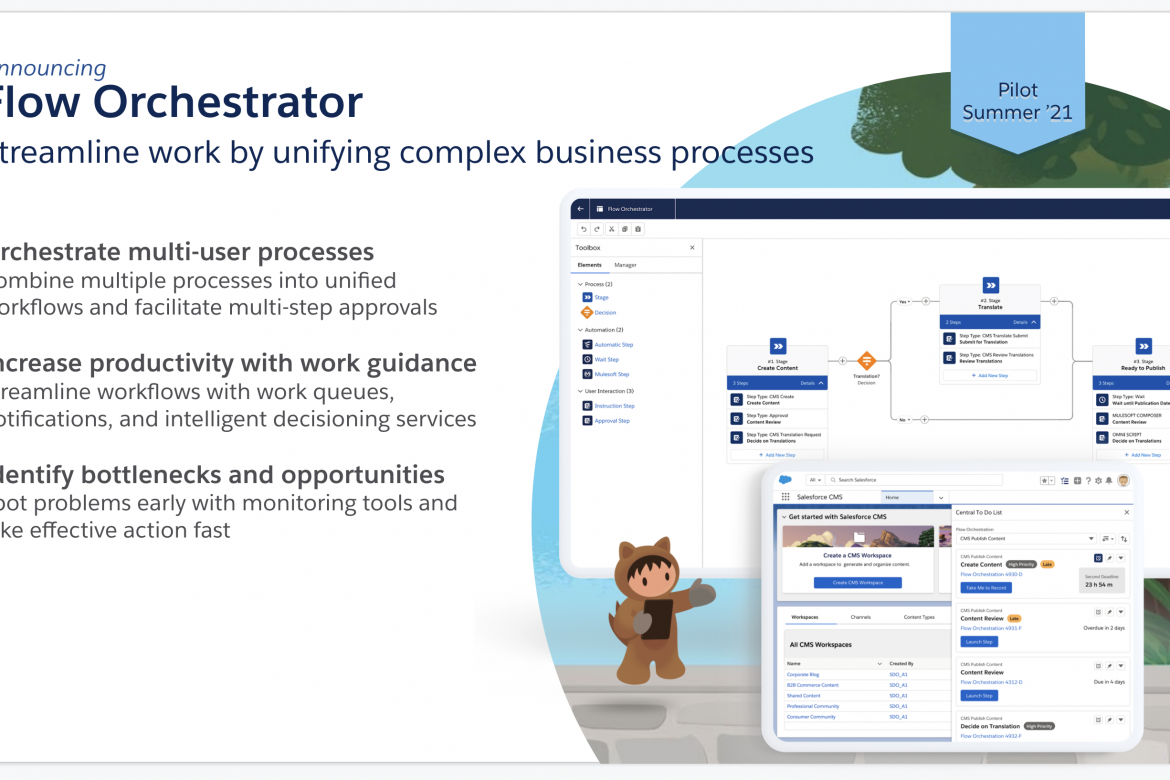Orchestrator is a new product that orchestrates multiple flows to enable sophisticated business processes to be built without code. Orchestrator is generally available and is available to try on all orgs.
In other words, we can say that the automated arrangement, board, and coordination of PC frameworks, programs, and services is known as orchestration. Orchestration helps IT manage complicated tasks and workflows more effectively.
Flow Orchestrator is designed to help managers/admins quickly build automated, multi-user, multi-stage multi-step business processes, with clicks, not code. You can link different flow, and authorization processes together, explaining that steps need to be completed sequentially, or together.
Rather than rebuilding your existing Flows to support a new feature, Flow Orchestrator is built with your current flow and allows you to use it in any new Orchestration. Flow helps to maximize your impact and create the best user experiences. Flow Orchestrator helps you to increase the impact of your new and existing flows with two new features –steps and stages.
Salesforce Flow Orchestrator is a new Flow functionality that allows Admins to string a Flows and business processes together across multiple people. Rather than rebuilding your existing Flows to support the new feature, Flow Orchestrator has been built with your existing Flows in mind and allows you to use them in any new Orchestration.
Flow Orchestrator is a tool that allows you to orchestrate multi-user, multi-step, and multi-stage Flows, which means Admins can create a string of automations that may need to be assigned to different people for action along the way.
Use of Flow Orchestrator
Flow Orchestrator can be used to benefit businesses. A few examples would be Service Delivery Orchestration (where multiple parties need to take various steps during a client delivery process in a specific order), public authorization, or escalation process where the record may need to be passed on to different team members depending on the terms that apply to the Orchestra.
Orchestrator’s no-code method allows you to orchestrate and transform Flows into steps structured by stages. This technique provides several advantages, including increased flexibility in creating approval processes, improved ability to delegate work to any Salesforce user, and greater control over record lifecycles.
Structure of Flow Orchestrator
Flow Orchestrator comprises stages, steps, and flow.
Stages
A phase is a set of linked steps organized into stages. The stages are performed sequentially, and a single-stage orchestration stage can continue at a specific time. It sets out the conditions that must be met for the stage to be considered complete.
Steps
They are built in stages and can be performed sequentially or simultaneously. User interaction is required in the intelligent stages. No user interaction is required in the basic phases.
Flow
It is a piece of Salesforce Automation used in the orchestration process. Screen flow is required in the intuitive stages, while auto-launched flow is required in basic steps.
How does it work?
Admins may create sophisticated multi-user, multi-step automated business processes using Flow Orchestrator by using clicks rather than coding.
You may combine your automated processes into a single point of interaction using Flow Orchestrator. Orchestrator’s no-code method allows you to orchestrate and transform Flows into steps structured by stages. This technique provides several advantages, including increased flexibility in creating approval processes, improved ability to delegate work to any Salesforce user, and greater control over record lifecycles. It is recommended that you use Flow Orchestrator and order your Record-Triggered Flows using Flow Trigger Explorer to automate complex procedures.
It allows users to create bots to handle basic, repetitive tasks; Einstein Document Reader, which uses AI to scan documents and make decisions based on data found within them; and Digital Process Automation, which allows brands to create branded digital encounters without writing any code, are joining Endlessly Flow Orchestrator. RPA automates repetitive human tasks, such as data segmentation and data extraction, by using simple bots that proceed through processes like a human doing the same
thing.
Types of Flow Orchestrator
Flow orchestrators are divided into two types:
-Orchestration that starts on its own
The REST API or an Apex class are used to physically start an auto-sending
orchestration. To be displayed on a Salesforce record page, it must be linked to a specific record ID.
-Orchestration Triggered by a Record
When a new record is made, updated, or wiped, a record-set-off orchestration is triggered by Salesforce. You have the option of starting the timer before or after the record is stored.
Benefits of Flow Orchestrator
-Increase your productivity while saving time
-Anything can be easily automated
-No need to juggle various frameworks and no bespoke code is necessary
-Improve your workflows by incorporating data effectively
-Increase visibility to help you get ahead of problems early
-Keep an eye on your orchestrations
Conclusion
Flow Orchestrator’s no-code method allows you to orchestrate and transform Flows into steps structured by stages. This technique provides several advantages, including increased flexibility in creating approval processes. Flow Orchestrator offers a much-needed solution to this issue.
It provides your team with the tools they need to automate complex, multi-user processes and approvals. Flow Orchestrator allows you to keep track of and smooth out your orchestrations. As you track the performance of individual executions, you can identify bottlenecks and opportunities. It provides vital visibility users require to spot issues before they get too large – allowing them to act quickly and effectively.



